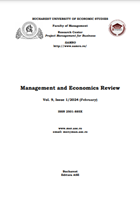Indigenous Preservation Practices and Shelf Life of Stored Yams in Benue State, Nigeria: Implication for Post-Harvest Management and Food Security
Indigenous Preservation Practices and Shelf Life of Stored Yams in Benue State, Nigeria: Implication for Post-Harvest Management and Food Security
Author(s): Emmanuel Verem Orjime, Benjamin G. Ahule, Godwin A. Akpehe, Solomon Gbaka, Victor Ushahemba Ijirshar, Kafayat O. ZakaSubject(s): National Economy, Business Economy / Management, Agriculture, Socio-Economic Research
Published by: EDITURA ASE
Keywords: indigenous; preservation; practices; yam; shelf-life; Benue State;
Summary/Abstract: Several empirical studies have been conducted on the relationship between indigenous practices and yam tuber preservation. However, there is a lack of empirical evidence regarding the extent of effectiveness of the existing indigenous preservation practices in reducing yam postharvest losses with regard to prolonging the shelf life, which underscores an existing gap in knowledge. The purpose of this study is to examine the extent of effectiveness of existing indigenous preservation practices in prolonging the shelf life of stored yam tubers in Benue State, Nigeria, using a cross-sectional survey design based on a proportional sampling technique involving 255 respondents. The result of the chi-square test shows the probability value of 0.000<0.05; hence, the study rejected the null hypothesis. A symmetric Phi value of 0.635 was obtained, showing a positive association between the variables. Thus, application of the existing indigenous yam preservation practices led to the overall improvement in the shelf life of stored yams by 34%. The study recommends that government and nongovernmental organizations should provide both financial and technical assistance to rural yam farming families, in the form of loan facilities. Yam farmers should also form cooperative societies in order to borrow more funds from financial institutions. This will boost the expansion of storehouses to accommodate the increasing quantity of yam tubers harvested, provide good ventilation in stores, and enhance free traffic during the removal of sprout development in storehouses to avert yam tuber postharvest losses and prolong the shelf life of the stored yam tubers in the study area.
Journal: Management and Economics Review
- Issue Year: 9/2024
- Issue No: 1
- Page Range: 25-40
- Page Count: 12
- Language: English

